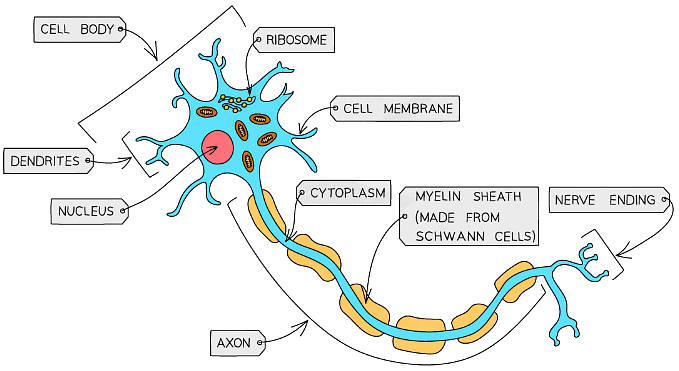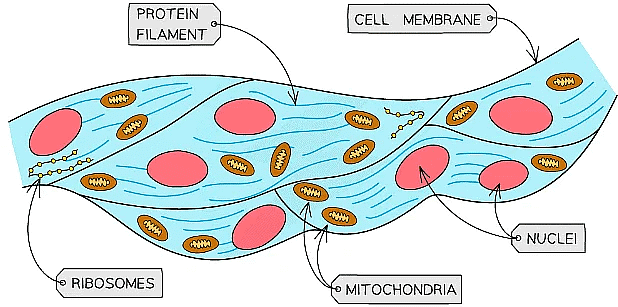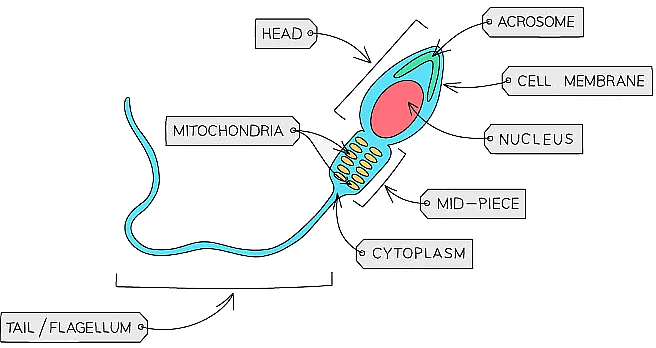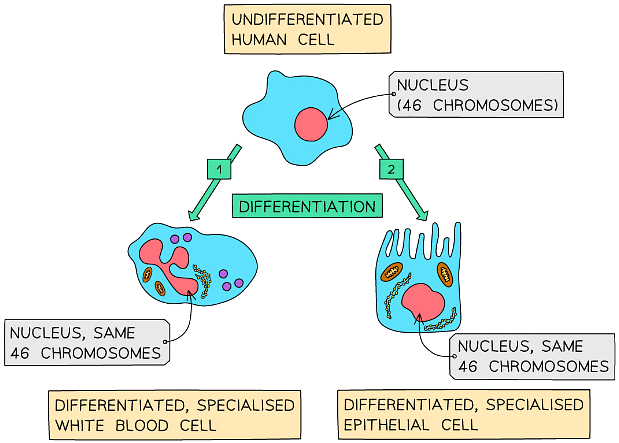Grade 10 Exam > Grade 10 Notes > Biology for Grade 10 > Cell Specialisation & Differentiation
Cell Specialisation & Differentiation | Biology for Grade 10 PDF Download
Specialised Cells
- You, as a human being, are made from trillions of cells, but only of about 250 different types
- A specialised cell is a cell that has a particular structure and composition of subcellular structures
- Structural differences between different types of cells enable them to perform specific functions within the organism
- Cells specialise by undergoing a process known as differentiation
Specialised Cells in Animals
The nerve cell

Nerve cells (neurones) have a characteristically elongated structure which allows them to coordinate information from the brain and spinal cord with the rest of the body
- Function: conduction of impulses
- Adaptations:
- Has a cell body where most of the cellular structures are located and most protein synthesis occurs
- Extensions of the cytoplasm from the cell body form dendrites (which receive signals) and axons (which transmit signals), allowing the neurone to communicate with other nerve cells, muscles and glands
- The axon (the main extension of cytoplasm away from the cell body) is covered with a fatty sheath, which speeds up nerve impulses. Axons can be up to 1m long in some animals
Muscle cells

Muscle cells contain layers of fibres which allow them to contract. The image above shows skeletal muscle cells
- Function: contraction for movement
- Adaptations:
- There are three different types of muscle in animals: skeletal, smooth and cardiac (heart)
- All muscle cells have layers of protein filaments in them. These layers can slide over each other causing muscle contraction
- Muscle cells have a high density of mitochondria to provide sufficient energy (via respiration) for muscle contraction
- Skeletal muscle cells fuse together during development to form multinucleated cells that contract in unison
A sperm cell

- Function: reproduction (pass on fathers genes)
- Adaptations:
- The head contains a nucleus which contains half the normal number of chromosomes (haploid, no chromosome pairs)
- The acrosome in the head contains digestive enzymes that can break down the outer layer of an egg cell so that the haploid nucleus can enter to fuse with the egg’s nucleus
- The mid-piece is packed with mitochondria to release energy (via respiration) for the tail
- The tail rotates, propelling the sperm cell forwards (allowing it to move/swim)
Specialised Cells in Plants
A root hair cell

The root hair is an extension of the cytoplasm, increasing the surface area of the cell in contact with the soil to maximise absorption of water and minerals
- Function: absorption of water and mineral ions from soil
- Adaptations:
- Root hair to increase surface area (SA) so the rate of water uptake by osmosis is greater (can absorb more water and ions than if SA were lower)
- Thinner walls than other plant cells so that water can move through easily (due to shorter diffusion distance)
- Permanent vacuole contains cell sap which is more concentrated than soil water, maintaining a water potential gradient
- Mitochondria for active transport of mineral ions
- Remember that chloroplasts are not found in these cells – there’s no light for photosynthesis underground!
A xylem vessel

Xylem cells lose their top and bottom walls to form a continuous tube through which water moves through from the roots to the leaves
- Function: transport tissue for water and dissolved ions
- Adaptations:
- No top and bottom walls between cells to form continuous hollow tubes through which water is drawn upwards towards the leaves by transpiration
- Cells are essentially dead, without organelles or cytoplasm, to allow free passage of water
- Outer walls are thickened with a substance called lignin, strengthening the tubes, which helps support the plant
Phloem cells

Phloem cells form tubes similar to xylem vessels, except the cells still retain some subcellular structures and are therefore living
- Function: transport of dissolved sugars and amino acids
- Adaptations:
- Made of living cells (as opposed to xylem vessels which are made of dead cells) which are supported by companion cells
- Cells are joined end-to-end and contain holes in the end cell walls (sieve plates) forming tubes which allow sugars and amino acids to flow easily through (by translocation)
- Cells also have very few subcellular structures to aid the flow of materials
Cell Differentiation
- Structural differences between different types of cells enables them to perform specific functions within the organism
- Cell differentiation is an important process by which a cell changes to become specialised
- Cells that have not differentiated are therefore unspecialised. As an organism develops, cells differentiate to form different types of cells
- Almost all of the cells in a multicellular organism will contain the same genetic information (the same genes or alleles), but depending on what role one particular cell needs to have, only some of the total sum of genes in a particular cell are used to control its development
- When a cell differentiates, it develops a structure and composition of subcellular structures which enables it to carry out a certain function
- To form a nerve cell the cytoplasm and cell membrane of an undifferentiated cell must elongate to form connections over large distances

Diagram showing the differentiation of a human cell
Differentiation & Development
- As a multicellular organism develops, its cells differentiate to form specialised cells
- In an animal, most cells differentiate at an early stage of its development. Cell division is mainly restricted to repair and replacement in mature animals
- Animal cells therefore lose their ability to differentiate after they have become specialised early in the life of the animal
- Some cells in various locations throughout the body of an animal retain the ability to differentiate throughout the life of the animal. These cells are called adult stem cells and are mainly involved in replacing and repairing cells (such as blood or skin cells)
- Plants differ from animals in that many types of plant cell retain the ability to fully differentiate throughout the life of a plant, not just in the early stages of development
The document Cell Specialisation & Differentiation | Biology for Grade 10 is a part of the Grade 10 Course Biology for Grade 10.
All you need of Grade 10 at this link: Grade 10
|
110 videos|105 docs|15 tests
|
Related Searches





















